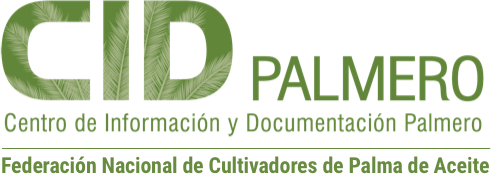| dc.creator | Linares Leguizamón, Omaira | |
| dc.creator | Santacruz Arciniegas, Libardo | |
| dc.creator | Rosero Estupiñán, Gustavo A. | |
| dc.date | 2020-04-08 | |
| dc.date.accessioned | 2020-07-25T11:21:51Z | |
| dc.date.available | 2020-07-25T11:21:51Z | |
| dc.identifier | https://publicaciones.fedepalma.org/index.php/palmas/article/view/12934 | |
| dc.identifier.uri | http://repositorio.fedepalma.org/handle/123456789/140882 | |
| dc.description | The hybrid material (Elaeis oleifera x Elaeis guineensis) has been of great importance for its high level of toleranceto pests and diseases, becoming a viable alternative to replace the Elaeis guineensis cultivars that wereattacked by diseases such as bud rot and red ring. On the other hand, one of the tasks required by this materialto reach its maximum productive potential, is the assisted pollination, which is constituted as one of the tasksthe agronomic more costly within the cultivation of oil palm (Ruiz et al., 2015 y Mosquera et al., 2017).The present work had as objective to assess artificial pollination in the hybrid material OxG (Elaeis oleiferax Elaeis guineensis), in aspects such as the formation of the cluster and the potential of oil between the assistedpollination traditional (talc more pollen) and artificial pollination with ANA (Naphthaleneacetic acid) moretalc evaluating two concentrations applied (120 mg and 210 mg) in two states of the inflorescence (anthesisand post anthesis); in the same way to identify factors that influence negatively in the work in order to seekcontinuous improvement in the logistics in the implementation of the work on a commercial basis. | en-US |
| dc.description | El material híbrido (Elaeis oleifera x Elaeis guineensis) ha sido de gran importancia por su alto nivel de tolerancia a plagas y enfermedades, convirtiéndose en una alternativa viable para reemplazar los cultivares Elaeis guineensis que son más susceptibles a enfermedades como la Pudrición del cogollo y Anillo rojo. Por otra parte, una de las actividades que requiere este material para alcanzar su máximo potencial productivo es la polinización asistida, la cual se constituye como una de las labores agronómicas más costosas dentro del cultivo de palma de aceite (Ruiz et al., 2015) y Mosquera et al., 2017). El presente trabajo tiene como objetivo evaluar la polinización artificial en el material híbrido OxG (Elaeis oleifera x Elaeis guineensis), en aspectos como la conformación del racimo y el potencial de aceite entre la polinización asistida tradicional (talco más polen) y la polinización artificial con ANA (Ácido naftalenacético) más talco, evaluando dos concentraciones aplicadas (120 mg y 210 mg) en dos estados de la inflorescencia (antesis y posantesis); de la misma manera identificar factores que influyen negativamente en la labor, con el fin de buscar la mejora continua en la logística de la implementación de la labor de manera comercial. | es-ES |
| dc.format | application/pdf | |
| dc.language | spa | |
| dc.publisher | Fedepalma | es-ES |
| dc.relation | https://publicaciones.fedepalma.org/index.php/palmas/article/view/12934/12801 | |
| dc.rights | Derechos de autor 2020 Revista Palmas | es-ES |
| dc.rights | http://creativecommons.org/licenses/by-nc-nd/4.0 | es-ES |
| dc.source | Revista Palmas; Vol. 40 Núm. 4 (2019); 96-105 | es-ES |
| dc.source | 0121-2923 | |
| dc.title | Evaluation of Artificial Pollination in the Hybrid Material OxG (Elaeis oleifera x Elaeis guineensis) | en-US |
| dc.title | Evaluación de la polinización artificial en el material híbrido OxG (Elaeis oleifera x Elaeis guineensis) | es-ES |
| dc.type | info:eu-repo/semantics/article | |
| dc.type | info:eu-repo/semantics/publishedVersion | |


